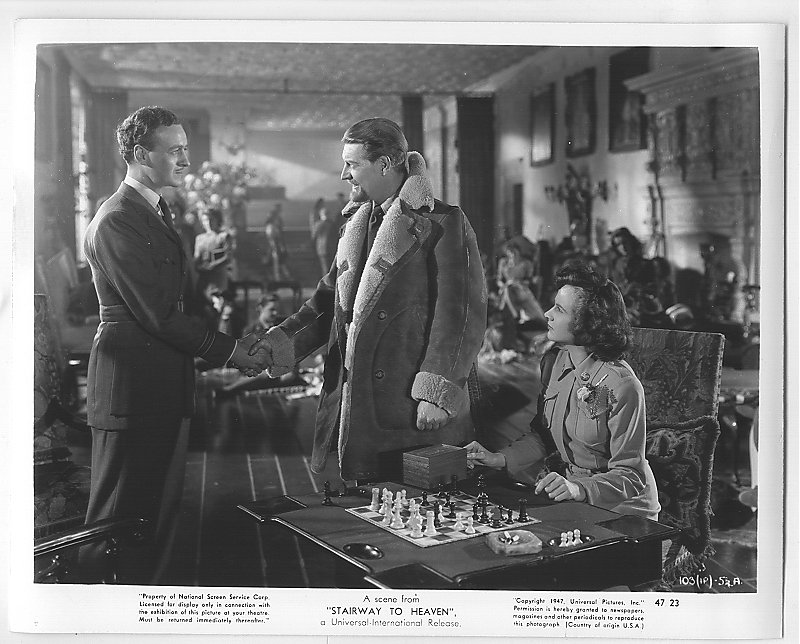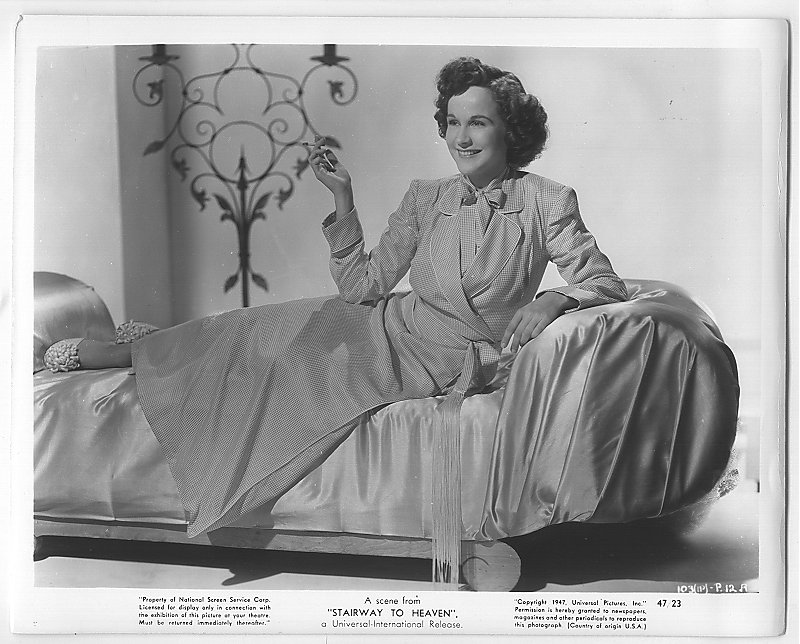Articles and reviews from FilmReel magazine.
Undated, but presumably some time in 1946 with
Marguerite Chapman on the cover.
Pleased to meet you - Miss Hunter
Slowly, one by one, British film stars are making the trek to Hollywood. Mr. Rank's "Lease-Lend" policy in this direction is certainly a good thing from the point of view of the stars themselves for this is about the surest method of getting your name known in the States. But whether it is so good from a British audience point of view I am not quite so sure.
In this country we have come to respect our feminine stars for retaining to a reasonable degree their natural appearance - one might almost term it their English appearance. What Hollywood quite does to our stars we don't now - but we do know the result and we don't lie it. A fine example of the "glamorising" of our stars into Hollywood replicas is Peggy Cummins who won our hearts for her fresh and natural attractions and the spontaneous warmth of her acting. Latest photographs of Peggy from Hollywood are - well, frankly, appalling. Another one of our stars who has submitted to this process is Lilli Palmer - in this case the result is not quite so tragic, but definitely not commendable.
The result of all this "glamorising" is that not only have we come to expect nothing but streamlined, sophisticated feminine robots from the States, but are almost of the belief that nothing else exists in their studios.
But this is where I have a surprise. And what a surprise! Needless to say, it shook me! This very attractive and welcome surprise stars in A Matter of Life and Death. I'd have almost mistaken her for a British star had it not been for that soft and soothing American burr. She's Kim Hunter, specially imported for A Matter of Life and Death, and she has everything to commend her to British audiences who feel the same way as I do about Hollywood replicas.
In the part of an American WAC who falls in love with a British airman and, through her love, manages to help him over a very difficult period, when his mind has been affected by the horrors of war, Kim has a touching depth of understanding. With her natural charm and sincerity, and her "very English" appearance, she is promised a great reception in this country.
But I wonder if it's because she is starred in a British film that Kim is so natural? That we shall not be able to tell until she has made another film in America - so far she has only had two small parts in Hollywood products. Anyhow, I'm glad that Mr. Rank gave Kim her first star role, and that she is now under contract to him to spend six months a year in this country making films. So we shall be seeing Kim again. But please Mr. American Producers, can't you find some more Kim Hunters for YOUR films?
[In fact Kim didn't go on to star in a series of British films. After AMOLAD, and an appearance in the US version of ACT, she didn't appear in any other British films until Bermuda Affair (1956). Instead, she returned to America and continued with a series of great roles starting with the Oscar© winning role as Stella in A Streetcar Named Desire (1951) and Zira in 3 of the Planet of the Apes films.]

David Niven, Kim Hunter and Roger Livesey in a dramatic moment from A Matter of Life and Death
|
Orville Raimond introduces you to Kim
In April, 1945, Michael Powell and Emeric Pressburger of the Archers went to the States and there conducted a 6,500 mile talent search for a "typical American girl" to play the part of the WAC heroine in A Matter of Life and Death. Out of the many actresses they interviewed they chose 23 year-old Kim Hunter, and in a short time she was on her way to this country - the first American actress to appear in a British film since before the war.
While still at school Kim had shown some talent for acting and had studied dramatics as well as singing and dancing. At first her parents were rather doubtful when Kim professed the ambition of making the stage her career, but they were soon won over to the idea when she made such a success of her first public appearance in 1940.
For three years Kim toured with stock companies - which in the States have the same reputation as our repertory companies for turning out the best actors and actresses. Her first important part came when she was chosen to play the lead in a production of Arsenic and Old Lace in Pasadena. On the advice of a talent scout David O. Selznick went to see Kim act. The result was a screen test and im was placed under contract. Her first screen appearance was in The Seventh Victim, and she had a supporting role in Tender Comrade, starring Ginger Rogers and Ruth Hussey, as a young war-bride.
In 1944 Kim was married to Captain William Baldwin of the United States Marine Corps, when she temporarily gave up her screen career. After the birth of her daughter Kathryn, she was doing voluntary work for the Red Cross when Michael Powell and Emeric Pressburger came along and gave her her first big film part, playing opposite David Niven in A Matter of Life and Death.
[Even though Kim was billed 4th in her first film, The Seventh Victim, most of the action focuses on her and she is on screen for a lot longer than the other actresses.]
[In his autobiography, Michael Powell says that Kim was acting as an off-camera stand-in, feeding Ingrid Bergman's lines to another actress during a screen test of another actress for Hitchcock's Spellbound. It was Hitchcock who suggested that Kim was the actress P&P wanted.]
Kim spent six months in this country, and in order to be near the Denham Studios she lived for a greater part of the time at Gerrards Cross. Here on a Sunday she could frequently be seen taking long country walks. To someone who has lived for the most part in california, the autumn countryside around a Buckinghamshire village proved a source of unending attraction to Kim. After shooting had ended on the film and Kim was waiting for a passage back to the States, she lived in town where she experienced her first "pea-souper" and also, to her dismay, the raw cold and dampness of an English winter. But the weather did not deter her from discovering many little shops in out-of-the-way side streets where she bought presents to tae back for her husband and mother. She was looking for things typical of Britain and British craftsmanship and finally decided on old English prints, antique jewellery and Paisley scarves.
Kim prefers the quiet life more common to stars of this country than those of America. She loves parties but likes them to be small and intimate, and her ideal of a day's holiday would be to spend it walking in the country, coming up to Town in the evening with a couple of friends to visit the theatre, and perhaps have dinner in a small restaurant in Soho. But she would be equally happy spending the evening at home making dresses for Kathryn or playing chess.
It's no joke
A Matter of Life and Death
Cert. A. Product of the Archers. Written, produced and directed by
Michael Powell and Emeric Pressburger
|
|
Peter Carter
Doctor Reeves
Abraham Farlan
June
Conductor 71
The Judge
Bob
An Angel
Chief Recorder
|
|
DAVID NIVEN
ROGER LIVESEY
RAYMOND MASSEY
Kim Hunter
Marius Goring
Abraham Sofar
Robert Coote
Kathleen Byron
Joan Maude
|
The tag "a stratospheric joke" which the producers have themselves applied to this remarkable film is unfortunate, not because there isn't some truth in it but because it would be quite horrible used as a final test of the whole picture. The joke is an intellectual joke, with little humour in the dialogue and a fair deal of wit. But that is merely one element in a film that contains most of the emotions known to man. These emotions, life-blood of any drama, are unleashed in this film by movement, colour and sincere acting; as always, the cinema's most powerful weapons. They overshadow the intellectual dance, and the sensation of the thin division between life and death is the emotion that pervades the film strongest of all. So the "a stratospheric joke", intellectual, becomes the grim joke, emotional. Yet the film has indissoluble unity. The empyrean argufying of the imaginary immortals blends with the prototypal love story of the boy and girl to produce a moving cry for the brotherhood of man, even if particularly in the shape of the Anglo-American box-office patron. Considering the film for what it has proved to be and not as a so-called stratospheric joke, we find the most powerful motivation, the element that grips us, is the theme of the lovers' agony of spirit in face of their possible separation forever, and their own and a doctor friend's effort to defeat the threat. Although most of the film shows us a dream or hallucination, all this, including the tension-relieving element of joke, the presentation of infinity, the opportunities for splendour, breath-takingly grasped with the finest degree of cinematic technical resource and imagination, all add up to a vivid, stimulating and, most especially, palatable way of making us feel the typical desperation of that typical young life-torn couple, so that we will ever afterwards sympathise the more deeply with their like in real life. It is that, personified by the warm, simple, telling acting of Kim Hunter, Roger Livesey and David Niven, which really makes the film big in stature. The joke, whether intentionally or not, becomes relatively much less important; were this not so, the whole gesture of the film, considering the realism of the burning 'plane sequence, would be in poor taste. As it stands, A Matter of Life and Death is a fine individual work of film art and entertainment, well integrated, and an emphatic "must" on any self-respecting film fan's list. Go and weep and laugh and be quickened and captivated.
Back to index



